Tens of millions of Americans under warnings as brutal storm barrels through the country bringing tornadoes and flooding – are you in its path?
A storm system consisting of tornadoes, hail and damaging winds will move through the Midwest by midweek before making its way east.
At dawn, thunderstorms were already visible across the plains, as well as at least two tornadoes.
One made landfall in Kansas and the other in southern Nebraska as the system continues to move northeast at speeds of about 45 mph. A third possible one was spotted around 11 a.m. in eastern Missouri, just north of Kansas City, where a tornado warning is still in effect.
The storms are poised to remain strong as they barrel through the Midwest, bringing the possibility of golf ball-sized hail and winds of 80 mph.
More tornadoes are also possible as more than 70 million Americans remain under a severe weather warning.
Scroll down for video:
A storm system consisting of tornadoes, hail and damaging winds will move through the Midwest on Tuesday before moving further east, meteorologists said
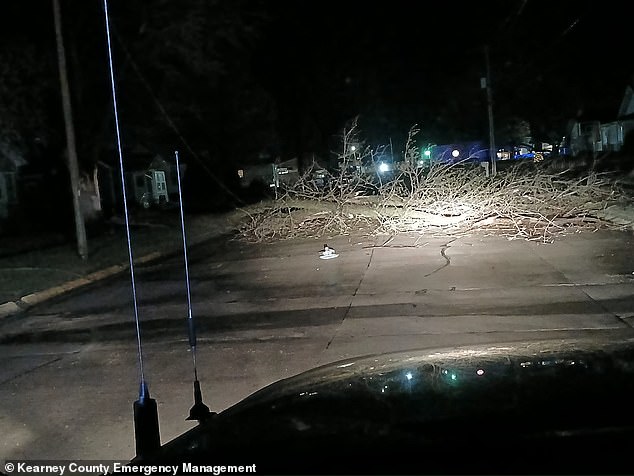
At least four to five homes in Nebraska were damaged by the storms last night, with photos from Kearney County showing fallen trees and branches blocking roads
“As we get into the afternoon hours of Tuesday, there is a chance of scattered thunderstorms across northern Illinois that could become severe,” David King, a meteorologist with the NWS in Chicago, said Tuesday of the system’s predicted path.
“And it looks like we have another round Wednesday morning that could also bring hail and high winds,” added Alex Gibbs, chief meteorologist with the NWS Quad Cities.
Both said Iowa and the Quad Cities will bear the brunt of the supercell, with King categorizing the risk level of severe weather — anything life-threatening — as a 2 out of 5.
Still, tornadoes are possible, after an already increased risk Monday across parts of Kansas and Nebraska.
On Tuesday, southern Iowa, northern Missouri and central Illinois will all see the greatest threat of “significant hail and tornadoes.”[es]the NWS said, while parts of Oklahoma, Missouri and Virginia are also at low risk.
Severe, scattered thunderstorms are also expected to bring strong winds, hail and flash flooding to these areas, meteorologists said, as May is generally considered the midpoint of tornado season.
However, Harold Brooks, a tornado scientist at the National Severe Storms Laboratory, said Tuesday that the strongest tornadoes occur in late April through mid-May — and when the most fatalities occur.
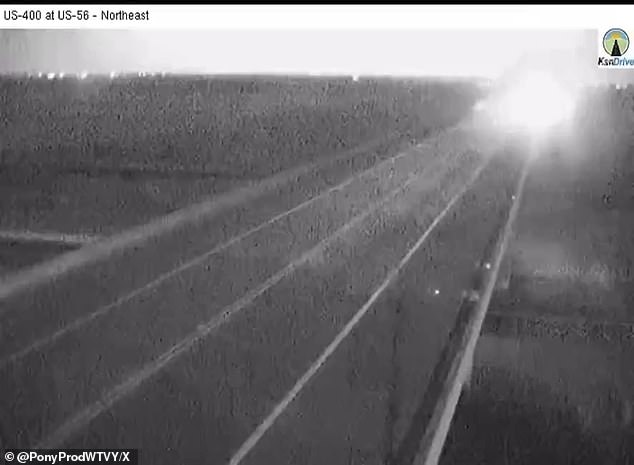
Blindingly bright lightning can be seen during the growing storm as it approached Dodge City, Kansas, Tuesday morning
![Tens of millions of Americans under warnings as brutal storm barrels through the country bringing tornadoes and flooding - are you in its path? 6 Southern Iowa, Northern Missouri and Central Illinois will all see the greatest threat of 'significant hail and tornadoes'[es]the NWS said, while parts of Oklahoma, Missouri and Virginia are also at low risk. In the photo the jet stream that supplies the supercell with fuel](https://nybreaking.com/wp-content/uploads/2024/04/1713283127_942_Tens-of-millions-of-Americans-under-warnings-as-brutal-storm.jpg)
Southern Iowa, Northern Missouri and Central Illinois will all see the greatest threat of ‘significant hail and tornadoes'[es]the NWS said, while parts of Oklahoma, Missouri and Virginia are also at low risk. In the photo the jet stream that supplies the supercell with fuel
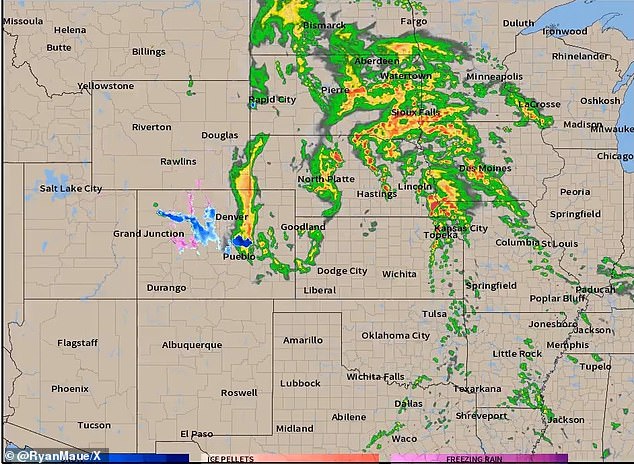
The storms – seen here – will remain strong as they barrel through the Midwest, bringing the potential for golf ball-sized hail and winds of 80 miles per hour.

Iowa and the Quad Cities will bear the brunt of the supercell, which will be hit with high winds, hail and flash flooding – and possibly tornadoes
Citing the fact that each tornado season varies from year to year, Brooks first denied, “There’s a lot of uncertainty in those estimates.”
However, the presence of tornadoes along the Mississippi River and farther east than the typical tornado area in recent decades has kept scientists like him guessing — as some theorize that one possible factor could be the western Great Plains becoming drier as consequence of climate change.
Earl Joe Strus, a meteorologist with the National Weather Service, was among that group, and joined the weather expert on Tuesday to conclude that this phenomenon is responsible for the precipitation “shifting a little bit to the east.”
Additionally, more storms are expected to hit Iowa and Arkansas, including Missouri, on Tuesday afternoon.
After moving through the Great Plains, the system will move into the Mississippi Valley and the Great Lakes and Ohio Valley areas, causing “severe weather and isolated flash flooding” before moving further east on Wednesday,
At that point, the system will still threaten parts of the Ohio Valley and southern U.S., with winds contributing to an increased fire risk in the Southwest.
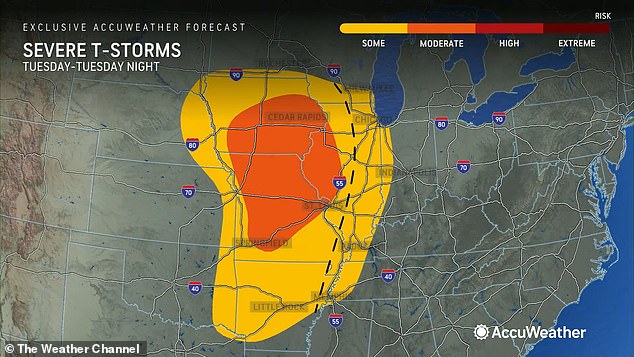
Additional storms are forecast to develop Tuesday afternoon in Iowa to Arkansas, including Missouri
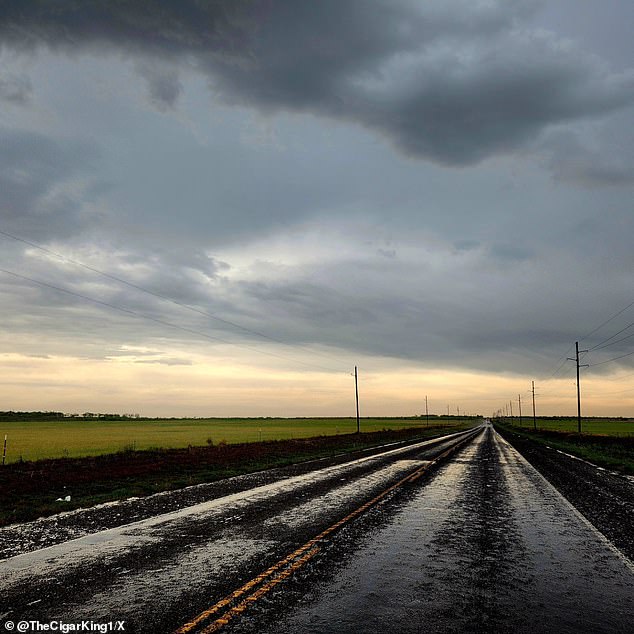
Scattered thunderstorms are likely Tuesday evening from Chicago all the way to eastern Dallas after storm chasers captured images of the fast-moving storm system early in the day in the Texas Big County, pictured, a two-lane tarmac after the storm on Tuesday morning
Scattered thunderstorms are likely from Chicago all the way east of Dallas Tuesday evening after storm chasers captured images of the fast-moving storm system in the Texas Big Country early in the day.
Around that time, law enforcement officials in Kansas reported that a tornado touched down southeast of Eureka around 4:45 a.m., putting Greenwood County under a tornado warning until 5 a.m.
No one was injured, but a recreational vehicle was reported destroyed in Osage County.
At least four to five homes southwest of Overbook were also damaged, as photos showed fallen trees and branches blocking roads.
Another tornado was spotted hours earlier in southern Nebraska, as areas further north were plagued by power outages and more storm damage.
A power outage was reported in the town of Juniata at 3 a.m., but power has since been restored.
Tree limbs were also blown down by winds exceeding 60 mph in nearby Kearny County, where a train derailed just before 4 a.m. a few miles to the east near the intersection of Highway 30 and Keystone Road, according to the County Sheriff’s Office Buffalo County.
Thunderstorms of 55 to 65 miles per hour were also seen in southern Nebraska, with one gust of 75 miles per hour.
Hail about the size of a quarter to a half dollar partially covered the ground in Edison, where windows were smashed due to the falling ice.
In far north-central Nebraska, on the other hand, golf ball-sized hail fell.
At 11 a.m., a possible tornado rotation was detected east of Smithville, Missouri, moving northeast at 50 mph, meteorologists said a few miles away in Kansas City.
It is not yet known if a twister has actually occurred and no injuries were reported as of 11:30 a.m. ET.
Shortly after 10 a.m., people in the storm’s path were urged to take cover.
“Move to a basement or interior room on the lowest floor of a sturdy building,” the National Weather Service said as it issued a tornado warning for parts of Clinton, Clay and Platte counties.
‘Avoid windows. If you are outside, in a mobile home or in a vehicle, go to the nearest shelter and protect yourself from flying debris.”
Scans taken by the agency just before noon showed the weather event has since disappeared.
This is a development story; come back for more updates.
